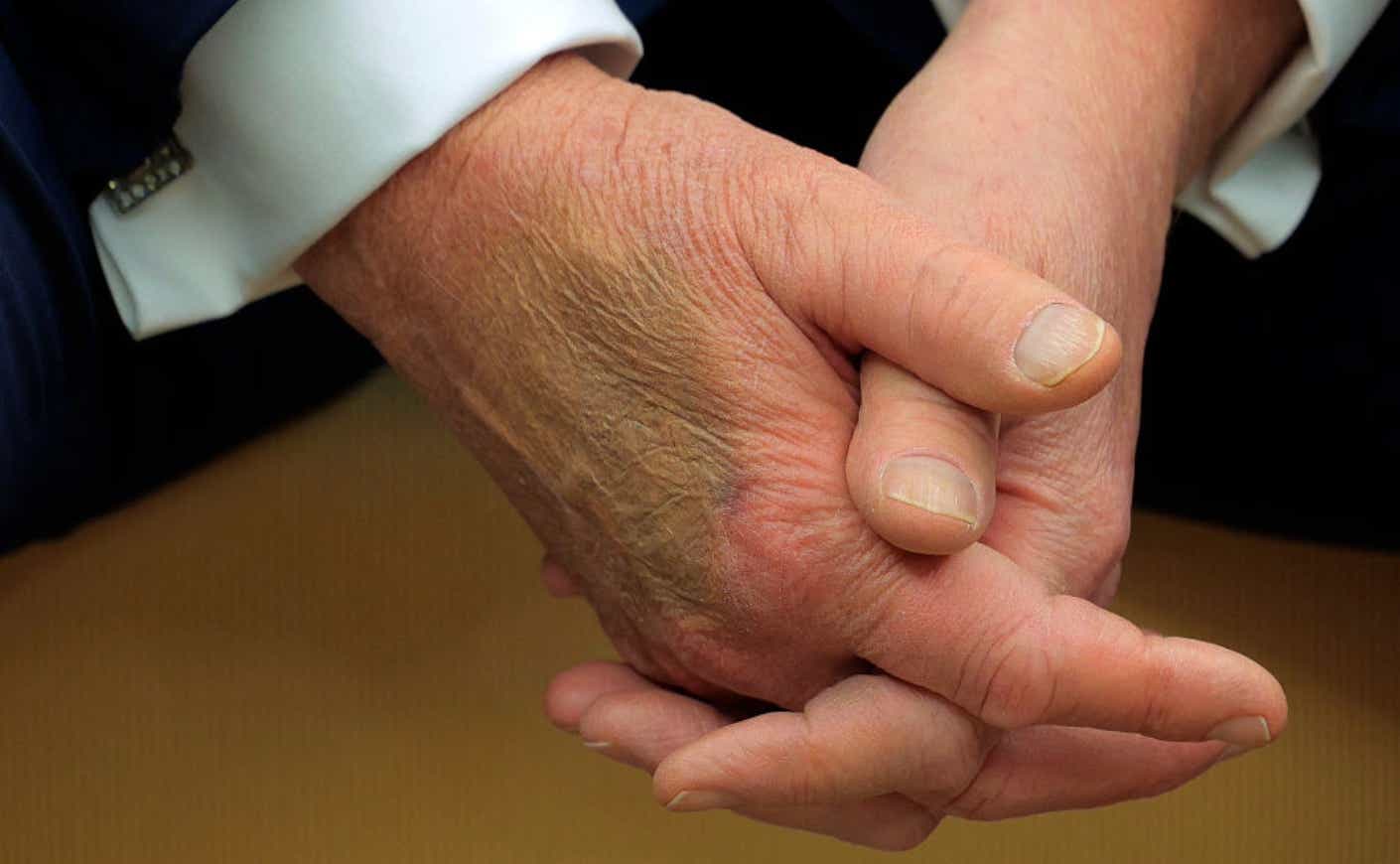President Donald Trump has recently been appearing at public events with swollen legs and dark bruises, sparking renewed scrutiny of his health. His attempts to hide the mark on his hand with poorly matched makeup have only fueled speculation, drawing attention — and criticism — from both sides of the aisle.
On Monday, the account Republicans Against Trump posted on X: “Yikes. The American people deserve answers about what’s going on with Trump’s hand.” The post has been viewed more than 1.1 million times. Even conspiracy theorist Alex Jones weighed in, calling it a health “crisis” and warning Trump could face a collapse within the next year.
Of course, Trump isn’t the first president to face questions about his health. Ronald Reagan’s unsteady signature after a 1981 assassination attempt, for example, drew fresh attention many years later, when he revealed his Alzheimer’s diagnosis. That scrutiny is sharper than ever today, says historian and political analyst Rich Rubino, with both the current and most recent president among the oldest to ever serve.
“We’ve never really seen this before. Yes, we’ve had older presidents — William Henry Harrison, Dwight Eisenhower, Ronald Reagan — but most have been much younger, often in their fifties,” Rubino notes. “Historically, health was more of a secondary concern. Now, with age front and center, it’s become a dominant question in how we view the presidency.”
Against that backdrop, we took a closer look at what’s really happening.
What’s behind Trump’s bruises and swelling?
As the oldest person ever sworn in as U.S. president, Trump, 79, has long faced questions about his health. Lately, the spotlight has turned to the visible bruising on his hands.
The first large mark appeared on the back of his right hand in February 2025. Even when covered with makeup, the discoloration was hard to miss, surfacing at high-profile events including a Feb. 24 meeting with French President Emmanuel Macron at the White House, a late-July gathering with European Commission President Ursula von der Leyen in Scotland, and a sit-down with U.K. Prime Minister Sir Keir Starmer.

The issue flared again as summer wore on. On Aug. 22, photos from Trump’s visit to the People’s House museum in Washington, D.C., showed his hand thickly coated in concealer. Over that same weekend, a smaller bruise appeared on his left hand during a golf outing with former Major League Baseball player Roger Clemens and his son Kacy at Trump National Golf Club in Virginia. Only a few days later, as he met with South Korean President Lee Jae-Myung, the bruise was unmistakable — dark and spread across the back of his right hand.
The concerns haven’t been limited to Trump’s hands. Photos of him at the FIFA Club World Cup last month showed swelling in his legs, which led the White House medical team to run a series of precautionary tests. According to officials, the results came back mostly normally, ruling out blood clots, heart problems, or other serious issues. Press Secretary Karoline Leavitt added that Trump hasn’t experienced any discomfort from the swelling.
What else do we know about Trump’s health?
That same evaluation in July found that Trump has chronic venous insufficiency, or CVI — a circulation issue in which the veins in the legs don’t move blood back to the heart efficiently. The condition is fairly common, with about 150,000 new cases diagnosed in the U.S. each year, according to the National Institutes of Health, and it’s most often seen in older adults, people who are overweight, or those who spend long periods sitting or standing. Experts note that while CVI can cause swelling and discomfort, it’s typically manageable with lifestyle adjustments like exercise, compression therapy, or leg elevation, and is not considered life-threatening.
But doctors say CVI doesn’t explain the bruises that keep appearing on Trump’s hands. “Hand bruising has nothing to do with venous insufficiency in the legs,” Peter Henke, immediate past chair of the American Heart Association’s Council on Peripheral Vascular Disease, told STAT. He noted that if Trump is taking aspirin — as many older adults do — it could make bruising more likely. Aspirin is often prescribed to lower the risk of heart attacks and strokes, but it also thins the blood, which means even a small bump can leave a visible mark.
Trump’s physician echoed that point in a recent report, saying the marks were “consistent with minor soft tissue irritation from frequent handshakes and the use of aspirin,” which the president takes as part of a standard cardiovascular prevention program.
Trump himself has brushed off the speculation. In a December interview with Time, he attributed the marks to one of the more occupational hazards of politics: “It’s from shaking hands with thousands of people.”
Still, even with these medical explanations, Rubino tells us that visible signs like bruising and swelling often take on outsized political weight — fueling speculation in a way that routine diagnoses alone rarely do.
“With Trump, though, it’s a little different,” Rubino adds. “Because he’s such a controversial president, health concerns haven’t always been front and center. The spotlight has been more on his policies — and especially his personality. That’s why questions about his health often end up taking a back seat to the larger trust issues that surround him.”
When was Trump’s last physical?
As he settled back into the presidency in early 2025, Trump’s health was given a fresh review — and the results painted a generally positive picture. On April 11, he underwent a full physical exam, and a few days later Capt. Sean Barbabella released a detailed memo declaring that Trump “remains in excellent health.”
According to the report, the 6-foot-3 president weighed 224 pounds — down from 244 at his previous White House physical in 2020 — and his blood pressure measured 128/74, which falls within the normal range.
The memo also offered a rare glimpse into Trump’s day-to-day medical routine. He takes two cholesterol medications — Rosuvastatin and Ezetimibe — along with a daily aspirin to protect his heart, and he uses Mometasone cream from time to time for a skin issue.
Routine procedures were noted as well: Trump has had cataract surgery in both eyes and a colonoscopy in July 2024, which showed diverticulosis and a benign polyp that was removed. All recommended vaccinations, including those for travel, were up to date.
The summary concluded that Trump is in “excellent cognitive and physical health” and “fully fit to execute the duties of the Commander-in-Chief.” Barbabella pointed to Trump’s active routine — made up mostly of public appearances, meetings, and regular rounds of golf — as a factor behind the positive results. Trump, for his part, seemed satisfied with the outcome, posting on social media ahead of the exam that he had “never felt better.”
Why are Trump’s latest health issues fueling speculation?
Historians like Rubino say past instances of dishonesty have shaped public skepticism — and he sees echoes of that with Trump. One classic example, he notes, is Grover Cleveland, who concealed a cancer surgery to avoid sparking panic during an economic downturn. Rubino also points out that the media’s role has shifted dramatically over time. Decades ago, reporters often looked the other way on health matters — Franklin D. Roosevelt’s wheelchair, for instance, was rarely shown to the public.
Still, Trump’s own record hasn’t helped. Over the years, he’s sometimes withheld information or made claims about his health that were later questioned. In 2015, his personal physician released a letter calling him “the healthiest person ever elected to the presidency” — only to later admit Trump had written the statement himself. “He dictated that whole letter,” Harold Bornstein told CNN in 2018. “I didn’t write that letter. I just made it up as I went along.”
That history has shaped how Americans see Trump’s health now. According to a YouGov/Economist poll released in May, 45 percent of respondents said he hasn’t been very transparent about his medical condition, while 42 percent felt he had been open enough. And now, more than 28,000 people have signed a petition urging him to release his full records.
All of this scrutiny seems to grate on the White House. According to The Daily Beast, staffers have largely brushed off the questions, describing Trump as “inexhaustible” and unstoppable. One insider even suggested they expect him to “just go over” suddenly, rather than show a gradual decline — a sign of how little they acknowledge aging or health vulnerabilities. Press secretary Davis Ingle echoed that message, pointing to a recent three-hour Cabinet meeting as evidence of Trump’s stamina.
While Trump may downplay the bruises, the speculation isn’t likely to fade. In an era when age and transparency loom large, every mark and stumble invites fresh attention.









